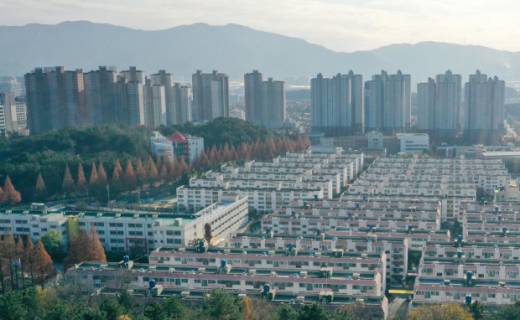The official price of apartments and other apartment houses in Gyeongnam region this year is up 10% compared to last year.
However, this is about half of that compared to the average increase in the public housing price of apartment houses nationwide by more than 19%.
As the publicly announced prices increase nationwide, the number of apartments exceeding the publicly announced price of 900 million won, which is subject to comprehensive real estate tax based on one household and one house, will increase by nearly 70% compared to last year.

View of apartment complex in Changwon area./Gyeongnam Newspaper DB/
The Ministry of Land, Infrastructure, and Transport announced on the 15th that it would read the ‘2021 public housing price plan’ from the 16th and listen to the owners’ opinions.
This year, the national average public housing price increase rate was calculated to be 19.08%.
The current government started to realize the official price, but there was no such a large rate of change.
The rate of increase in the public housing price for apartment houses has been on a gentle upward curve from 4.44% in 2017 to 5.02% in 2018 and 5.23% in 2019, followed by 5.98% last year, but this year suddenly took a double-digit increase.
It is the highest in 14 years since the 22.7% in 2007, when the publicly announced prices were raised a lot at the same time during the past participatory government.
Looking at the rate of increase in official prices by province and province, Gyeongnam has increased from -3.79% last year to 10.15% this year. Until now, the rate of change in the official price of apartment housing in Gyeongnam has declined, recording -1.59% in 2017, -5.30% in 2018, -9.69% in 2019, and -3.79% in 2020. Like Gyeongnam, Ulsan, where the official price fell last year, was -1.51% last year, but this year it turned upward to 18.68%, while Chungbuk changed from -4.40% to 14.21%, and Daegu from -0.01% to 13.14%.

The Ministry of Land, Infrastructure and Transport explained that the’Public Price Realization Roadmap’ announced last year was applied to calculate the public housing price this year.
The median official price is 160 million won nationwide, and Sejong is the most expensive with 432 million won by region, followed by Seoul 380 million won and Gyeonggi 280 million won, followed by Gyeongnam with 140 million won. . The median price ranking has changed for the first time since 2006, when the apartment price disclosure was implemented. Property taxes, such as property taxes, are also expected to rise sharply in Sejong, Daejeon, Busan, and the metropolitan area, where publicly announced prices have soared.
A government official estimated that “this year’s increase in public housing prices will increase the property tax by about 360 billion.”
A plan to ease the burden of health insurance premiums arising from fluctuations in the published price has also been prepared and will be applied from this November.
Under the current system, an average monthly premium of about 2,000 won per household can be raised, but the government plans to lower the premium by increasing the property deduction by an additional 5 million won when calculating insurance premiums for local subscribers. In this case, the insurance premium burden of 7.3 million local affiliated households, 89% of all locally subscribed households, can be reduced by 2,000 won per month on average.
The number of apartment houses subject to disclosure this year is 14.25,000 units (852,000 units in Gyeongnam), an increase of 2.7% from 1,383 million units last year.
The proposed public housing price plan is scheduled to be decided and disclosed on the 29th after receiving opinions from the owners by the 5th of next month and after deliberation by the Central Real Estate Price Disclosure Committee.
From the 16th, the published price plan can be viewed on the website (www.realtyprice.kr) and the Civil Affairs Office of City/Gun/Gu offices.
Reporter Seulgi Lee [email protected]
